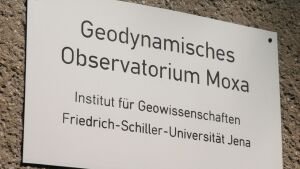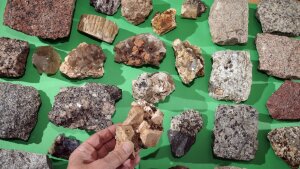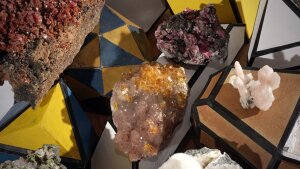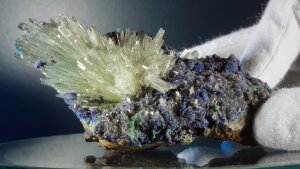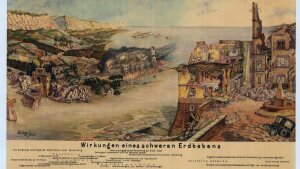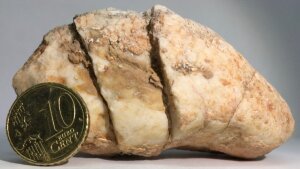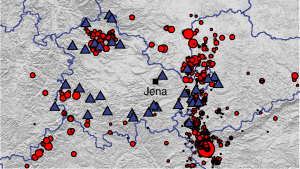
Welcome to the Institute for Geosciences at the Friedrich-Schiller-University Jena!
Geology, mineralogy and geophysics are sciences that deal with the coupled processes between the different parts of the earth in different spatial and temporal dimensions, from fractions of a nanometer to thousands of kilometers.
From the smallest structures of minerals, rocks and organic (macro)molecules to the global scale, for example with the motion and dynamics of huge lithosphere plates.
In order to understand the complex interrelationships of processes that transcend scales, the geosciences have undergone a profound transformation over the last 20 years into an exact quantitative science.
Processes that occur on the earth's surface or in the earth's interior can now be mathematically modeled in many cases from the atomic to the planetary scale.
With the help of experiments, extreme conditions can be simulated up to those that prevail in the earth's core. State-of-the-art high-resolution microscopic, tomographic and spectroscopic investigation methods allow a fundamental understanding of the structure-property relationships of geomaterials.
The Institute of Geosciences (IGW) represents the merger of the disciplines geology, geophysics and mineralogy. A special feature of the IGW in Jena is the close interdisciplinary integration with chemistry, biology and physics. The research groups of the institute investigate fundamental geological and environmental processes, especially the interrelations, interactions and feedbacks between litho-, pedo-, hydro- and biosphere.
Geology
investigates the structure and history of the earth, the development of the continents and oceans, the formation and erosion of mountains and the formation of depositional spaces and sedimentary rocks. It provides the basic information for the extraction of raw materials. It has the task of securing the basis of human life - such as soil and water - in a long-term and sustainable manner.
Geophysics
investigates the physical properties of the earth and answers fundamental questions about the physical and thermal development of the earth and the structure of the continents. The structure of the earth is investigated with geophysical and numerical models.
Mineralogy
studies the composition, structure and properties of natural minerals and rocks that make up the earth's crust. These investigations provide important stimuli for the development of technically significant solids such as glasses, ceramics or semi-metals and new functional materials that have become essential components in everyday life.
The range of courses offered at the IGW includes the two bachelor and master courses of study in Earth Sciences and Biogeosciences as well as the master's degree program in environmental and georesource management.
Maybe we can win you over by giving you an insight into research and teaching as a student, but also as an interested party/supporter of the Institute of Geosciences Jena for our offers such as Rent-A-Prof for schools and educational institutions in Thuringia, or welcome you personally here at the institute. In addition, lectures and other events take place at regular intervals, to which the public is also cordially invited.
-
By Train
North-South (Munich-Berlin): Arrival Jena-Paradies.
Line 1 (streetcar) in the direction of Zwätzen (city center). Take only one station. At the Löbdergraben stop, change to line 16 (bus) in the direction of Ziegenhainer Tal to the Kernbergstraße stop. Cross the street and walk uphill. Opposite the pharmacy, a small footpath branches off to the left. At the end of the footpath you reach Burgweg and see the institute opposite.
East-West (Weimar-Gera): Arrival Jena-West
Bus line 15 in the direction of Rautal. At the Löbdergraben stop, change to line 16 (bus) in the direction of Ziegenhainer Tal to the Kernbergstraße stop. Cross the street and walk uphill. Opposite the pharmacy, a small footpath branches off to the left. At the end of the footpath you reach Burgweg and see the institute opposite. -
By Car
A4 - Frankfurt-Dresden: Exit Jena Lobeda, in the direction of the city center, Naumburg, just before the Saale bridge turn right into Friedrich-Engels-Straße, then first street on the left "Camsdorfer Ufer", again first street on the right into Burgweg. The institute is located on the left side.
A9 - Berlin-Nürnberg: Exit Eisenberg in the direction of Jena on the B7 (approx. 20 km); approx. 1-1.5 km after the city limits sign of Jena turn left in the direction of the center, shortly before the Saale bridge (see city map) turn left again into the street "Camsdorfer Ufer". The second street on the left is Burgweg.
B88 - from direction Naumburg: In Jena follow the signs Zentrum, then in the center turn left under the railroad line into Karl-Liebknecht-Straße. Directly after the Saale bridge turn right into the street "Camsdorfer Ufer". The second street on the left is Burgweg.
B7 - from Weimar: In the center of Jena follow the signs to Eisenberg. Directly after the Saale bridge turn right into the street "Camsdorfer Ufer". The second street on the left is Burgweg.
-
Geodynamic Observatory Moxa
Geodynamic Observatory Moxa
In the geodynamic observatory Moxa, among other things, the deformations of the earth's surface and the gravity field are recorded, evaluated and interpreted.
-
Geological collection
-
historical collection of geophysical/seismological equipment
historical collection of geophysical/seismological equipment
The extensive and unique collection of measuring instruments for recording ground motions, which is maintained by the geophysicists of the Moxa Geodynamic Observatory and the Department of Applied Geophysics of the Friedrich Schiller University Jena, is attracting worldwide attention.
want to know more?
-
Teaching collection of models of mineralogy
-
Mineralogical collection
Mineralogical collection
Founded in 1779, the Mineralogical Collection holds approximately 80,000 objects and is intensively involved in research and teaching in the field of geosciences and biogeosciences.
-
Seismogram archive
Seismogram archive
Around 1900, the recording of earthquakes begins worldwide. The seismogram archive of the Department of Applied Geophysics at Friedrich Schiller University contains records of earthquake waves from 1903 to the present day.
want to know more?
-
Tectonic collection
Tectonic collection
The tectonic collection houses hand pieces of naturally deformed rocks from different parts of the world. The objects illustrate a wide range of deformation structures, which are formed as a result of the action of stresses and temperatures on rocks.
-
Thuringia Seismic Network
Thuringia Seismic Network
The task of the Thuringian Seismic Network (TSN) is to perform seismological monitoring of the region of Thuringia and Western Saxony.
